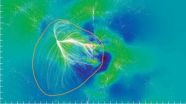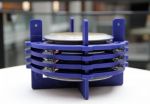(Press-News.org) Astronomers using the National Science Foundation's Green Bank Telescope (GBT) -- among other telescopes -- have determined that our own Milky Way galaxy is part of a newly identified ginormous supercluster of galaxies, which they have dubbed "Laniakea," which means "immense heaven" in Hawaiian.
This discovery clarifies the boundaries of our galactic neighborhood and establishes previously unrecognized linkages among various galaxy clusters in the local Universe.
"We have finally established the contours that define the supercluster of galaxies we can call home," said lead researcher R. Brent Tully, an astronomer at the University of Hawaii at Manoa. "This is not unlike finding out for the first time that your hometown is actually part of much larger country that borders other nations."
The paper explaining this work is the cover story of the September 4 issue of the journal Nature.
Superclusters are among the largest structures in the known Universe. They are made up of groups, like our own Local Group, that contain dozens of galaxies, and massive clusters that contain hundreds of galaxies, all interconnected in a web of filaments. Though these structures are interconnected, they have poorly defined boundaries.
To better refine cosmic mapmaking, the researchers are proposing a new way to evaluate these large-scale galaxy structures by examining their impact on the motions of galaxies. A galaxy between structures will be caught in a gravitational tug-of-war in which the balance of the gravitational forces from the surrounding large-scale structures determines the galaxy's motion.
By using the GBT and other radio telescopes to map the velocities of galaxies throughout our local Universe, the team was able to define the region of space where each supercluster dominates. "Green Bank Telescope observations have played a significant role in the research leading to this new understanding of the limits and relationships among a number of superclusters," said Tully.
The Milky Way resides in the outskirts of one such supercluster, whose extent has for the first time been carefully mapped using these new techniques. This so-called Laniakea Supercluster is 500 million light-years in diameter and contains the mass of one hundred million billion Suns spread across 100,000 galaxies.
This study also clarifies the role of the Great Attractor, a gravitational focal point in intergalactic space that influences the motion of our Local Group of galaxies and other galaxy clusters.
Within the boundaries of the Laniakea Supercluster, galaxy motions are directed inward, in the same way that water streams follow descending paths toward a valley. The Great Attractor region is a large flat bottom gravitational valley with a sphere of attraction that extends across the Laniakea Supercluster.
The name Laniakea was suggested by Nawa'a Napoleon, an associate professor of Hawaiian Language and chair of the Department of Languages, Linguistics, and Literature at Kapiolani Community College, a part of the University of Hawaii system. The name honors Polynesian navigators who used knowledge of the heavens to voyage across the immensity of the Pacific Ocean.
INFORMATION:
The other authors are Hélène Courtois (University Claude Bernard Lyon 1, Lyon, France), Yehuda Hoffman (Racah Institute of Physics, Hebrew University, Jerusalem), and Daniel Pomarède (Institute of Research on Fundamental Laws of the Universe, CEA/Saclay, France).
The GBT is the world's largest fully steerable radio telescope. Its location in the National Radio Quiet Zone and the West Virginia Radio Astronomy Zone protects the incredibly sensitive telescope from unwanted radio interference.
The National Radio Astronomy Observatory is a facility of the National Science Foundation, operated under cooperative agreement by Associated Universities, Inc.
Founded in 1967, the Institute for Astronomy at the University of Hawaii at Manoa conducts research into galaxies, cosmology, stars, planets, and the sun. Its faculty and staff are also involved in astronomy education, deep space missions, and in the development and management of the observatories on Haleakala and Maunakea. The Institute operates facilities on the islands of Oahu, Maui, and Hawaii.
A short video about Laniakea that gives the viewer a general sense of the structure of our home supercluster and of galaxy motions in the nearby universe is available at http://vimeo.com/104704518.
Contacts:
Charles E. Blue, Public Information Officer
National Radio Astronomy Observatory
+1 (434) 296-0314; Email: cblue@nrao.edu
Dr. R. Brent Tully
+1 808-956-8606; tully@ifa.hawaii.edu
Dr. Roy Gal
Cell: +1 301-728-8637, rgal@ifa.hawaii.edu
Ms. Talia Ogliore, Media Contact
(808) 956-4531; togliore@hawaii.edu
Newly identified galactic supercluster is home to the Milky Way
2014-09-03
ELSE PRESS RELEASES FROM THIS DATE:
Longitudinal study explores white matter damage, cognition after traumatic axonal injury
2014-09-03
Traumatic Axonal Injury is a form of traumatic brain injury that can have detrimental effects on the integrity of the brain's white matter and lead to cognitive impairments. A new study from the Center for BrainHealth at The University of Texas at Dallas investigated white matter damage in the acute and chronic stages of a traumatic axonal injury in an effort to better understand what long-term damage may result.
The study, published online July 21 in the Journal of Neurotrauma, looked at 13 patients ages 16 to 60 with mild to severe brain injuries from the intensive ...
Bariatric surgical center accreditation improves patient survival and postop complications
2014-09-03
CHICAGO (September 3, 2014): Patients who underwent weight loss operations in recent years, when most bariatric surgical centers were accredited, had fewer postoperative complications and were 2.3 times less likely to die in the hospital than patients who had bariatric procedures performed before a national movement toward facility accreditation was taking place, according to new study findings. Study authors, who published their results in the September issue of the Journal of the American College of Surgeons, say these findings suggest that accreditation of bariatric ...
Is a gluten-free diet enough to control the complications of celiac disease?
2014-09-03
New Rochelle, NY, September 2, 2014—A lifelong gluten-free diet (GFD) is the conventional approach to managing celiac disease, a chronic inflammatory disorder affecting the small intestine that can result in malnutrition. However, recent evidence shows that a GFD may not be sufficient to prevent serious complications related to celiac disease. A detailed discussion of the metabolic disorders and functional abnormalities that can develop, and nutritional treatments for these is presented in a Review article published in Journal of Medicinal Food, a peer-reviewed journal ...
Innovative algorithm spots interactions lethal to cancer
2014-09-03
Despite the revolutionary biotechnological advancements of the last few decades, an ideal anti-cancer treatment — one that's immediately lethal to cancer cells, harmless to healthy cells, and resistant to cancer's relapse — is still a dream.
But a concept called "synthetic lethality" holds great promise for researchers. Two genes are considered synthetically lethal when their combined inactivation is lethal to cells, while inhibiting just one of them is not. Synthetic lethality promises to deliver personalized, more effective, and less toxic therapy. If a particular gene ...
Transplanted stem cells help prevent bladder fibrosis after spinal cord injury
2014-09-03
Putnam Valley, NY. (Sept. 3, 2014) – A team of researchers from Korea and Canada have found that transplantation of B10 cells (a stable immortalized human bone marrow derived –mesenchymal stem cell line; B10 hMSC) directly into the bladder wall of mice modeled with spinal cord injury (SCI) helped inhibit the development of bladder fibrosis and improved bladder function by promoting the growth of smooth muscle cells in the bladder.
The study will be published in a future issue of Cell Transplantation and is currently freely available on-line as an unedited early e-pub ...
Penn study: Sepsis patients fare better in hospitals with higher case volumes
2014-09-03
PHILADELPHIA – Patients with sepsis, one of the most time-sensitive and hard-to-detect illnesses in medicine, are more likely to survive the life-threatening condition when treated at a hospital that sees a higher volume of sepsis cases. New research from the Perelman School of Medicine at the University of Pennsylvania shows a clear relationship between hospitals that treat the most cases of severe sepsis and lower rates of inpatient deaths among those patients. The study, led by David F. Gaieski, MD, an associate professor of Emergency Medicine at Penn, is published online ...
Pesticide risk assessments seen as biased
2014-09-03
In the October issue of BioScience, a group of ecotoxicologists argue that the US Environmental Protection Agency's (USEPA) current practices for evaluating pesticide safety are inadequate and likely to result in decisions biased toward industry interests.
In their article, Michelle Boone of Miami University and her colleagues note that most pesticide toxicity tests used in risk assessments are conducted by pesticide manufacturers themselves, which the authors believe can result in untenable conflicts of interest. Moreover, rigid inclusion criteria often mean that potentially ...
Seizures and sudden death: When SUMO 'wrestles' potassium channels
2014-09-03
A gene crucial for brain and heart development may also be associated with sudden unexplained death in epilepsy (SUDEP), the most common cause of early mortality in epilepsy patients.
Scientists at The University of Texas MD Anderson Cancer Center have created a new animal model for SUDEP and have shown that mice who have a partial deficiency of the gene SENP2 (Sentrin/SUMO-specific protease 2) are more likely to develop spontaneous seizures and sudden death. The finding occurred when observing mice originally bred for studying a link between SENP2 deficiency and cancer.
"SENP2 ...
Researchers unlock new mechanism in pain management
2014-09-03
It's in the brain where we perceive the unpleasant sensations of pain, and researchers have long been examining how calcium channels in the brain and peripheral nervous system contribute to the development of chronic pain conditions.
Neuroscientist Gerald Zamponi, PhD, and his team at the University of Calgary's Hotchkiss Brain Institute have discovered a new mechanism that can reverse chronic pain. Using an animal model, their research has found that pain signals in nerve cells can be shut off by interfering with the communication of a specific enzyme with calcium ...
Changing temperature powers sensors in hard-to-reach places
2014-09-03
A centuries-old clock built for a king is the inspiration for a group of computer scientists and electrical engineers who hope to harvest power from the air.
The clock, powered by changes in temperature and atmospheric pressure, was invented in the early 17th century by a Dutch builder. Three centuries later, Swiss engineer Jean Leon Reutter built on that idea and created the Atmos mechanical clock that can run for years without needing to be wound manually.
Now, University of Washington researchers have taken inspiration from the clock's design and created a power ...



